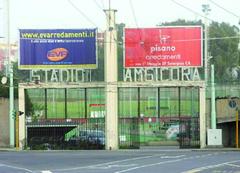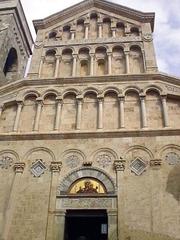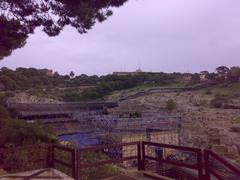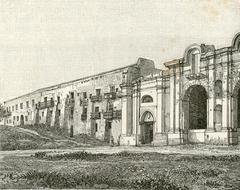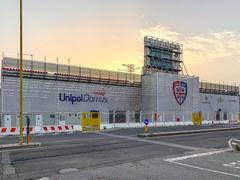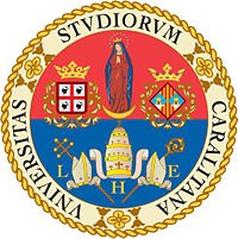
Port of Cagliari Visiting Hours, Tickets, and Travel Guide
Date: 04/07/2025
Introduction
Nestled on Sardinia’s southern coast, the Port of Cagliari is a vibrant maritime gateway that intertwines ancient history with modern vitality. As one of Italy’s largest and most strategically important seaports, it has played a pivotal role in Mediterranean trade, military affairs, and cultural exchange since prehistoric times (Nomads Travel Guide; MedCruise). Today, it welcomes travelers eager to experience Cagliari’s rich heritage, including landmarks like the Castello district, the Roman amphitheater, and the Castello di San Michele (Italy This Way; CagliariTurismo).
This guide details the port’s visiting hours, ticketing, accessibility, and the best ways to explore Cagliari’s historical and cultural sites, whether you arrive by cruise, ferry, or plan a dedicated visit (Tourist Secrets; Sardinia Revealed).
Table of Contents
- Introduction
- History and Cultural Significance
- Historical Evolution
- Modern Significance and Infrastructure
- Recent Developments
- The Port’s Place in City Life
- Visitor Experience: Hours, Tickets, Accessibility
- Must-See Attractions
- Dining, Shopping, and Events
- Practical Visitor Information
- Frequently Asked Questions
- Conclusion & Call to Action
- References & Official Resources
History and Cultural Significance
Ancient Foundations
Human settlement in the Cagliari area dates back to around 3000 BCE, evidenced by Nuragic ruins from Sardinia’s Bronze Age civilization (Nomads Travel Guide; Italia.it). By the 8th century BCE, the Phoenicians established Karalis—a critical trading post leveraging the port’s natural advantages.
Carthaginian and Roman Eras
The Carthaginians fortified Karalis in the 6th century BCE, transforming it into a key commercial and military outpost (Nomads Travel Guide). Following the First Punic War, Roman rule brought further expansion. The city, renamed Caralis, became a provincial capital and essential naval base, with significant investments in infrastructure (Italia.it).
Medieval to Modern Transformations
After the fall of Rome, Cagliari faced periods of Vandal and Byzantine control before emerging as a medieval stronghold. The Pisans fortified the city in the 11th century, leaving behind iconic towers like Torre di San Pancrazio and Torre dell’Elefante (Adventour Begins). Later, Aragonese and Spanish rulers expanded the port’s reach, a process accelerated under the Savoy dynasty and after Italian unification (Nomads Travel Guide).
Contemporary Significance
Today, the Port of Cagliari is a major Mediterranean hub, handling up to 50 million tonnes of cargo annually and supporting thousands of jobs (Wikipedia; GoComet). The port comprises the historic waterfront and the modern Canal Port, which houses the Cagliari International Container Terminal (Wikipedia).
Modern Significance and Infrastructure
- Historic Port: 5,800 meters of quay for commercial, Ro-Ro, and passenger traffic, closely linked to the city center (GoComet).
- Canal Port: Dedicated to transshipment and Ro-Ro operations, with a capacity of 1,000,000 TEUs (Wikipedia).
- Specialized Berths: Serve petrochemical and oil industries, with strategic proximity to key Mediterranean shipping lanes (Wikipedia).
Recent Developments
Over €780 million has been invested in recent years, including a major new Ro-Ro terminal, reorganization of bulk storage, and road improvements (Ports Europe). With 22.86 million tonnes handled in the first nine months of 2024, Cagliari remains a leader among Italian ports.
The Port’s Place in City Life
The Port of Cagliari is woven into the city’s fabric. Its revitalized waterfront features cruise terminals, promenades, and direct links to the historic center, making it easy to explore the Castello district, medieval towers, and bustling markets (DIY Cruise Ports; WhatsInPort). The port is also a springboard to Sardinia’s famed beaches and natural parks (Tourist Secrets; Transfeero).
Visitor Experience: Hours, Tickets, & Accessibility
- Port Hours: Operational 24/7 for commercial and passenger activity. Cruise terminal and ticket offices: typically 8:00 AM–8:00 PM. Confirm specific hours before visiting.
- Tickets & Tours: Access to the port is free. Tickets are needed for guided tours and entry to certain historical sites, bookable via local agencies or information centers.
- Accessibility: Facilities are equipped with ramps, elevators, and accessible shuttles. Some historic sites may have uneven terrain.
- Events: The port often hosts maritime festivals and markets. Check official sources for event updates.
Must-See Attractions
Within Walking Distance
- Palazzo Civico di Cagliari: Art deco town hall with free entry, open Mon–Fri, 9:00 AM–6:00 PM (Italy This Way).
- Via Roma: Arcaded boulevard with shops and cafes overlooking the port.
- Castello Quarter: Medieval heart of the city, with the 13th-century cathedral and panoramic towers.
- Museum Citadel: Includes the National Archaeological Museum and other collections, open Tue–Sun, 9:30 AM–7:00 PM (Isla Guru).
- Roman Amphitheater: Ancient arena (daily 9:00 AM–6:00 PM, €4 entry).
Natural Attractions
- Poetto Beach: 5 km from the port, accessible by frequent buses from Via Roma.
- Parco Molentargius – Le Saline: Wetland park known for flamingos and walking trails.
Dining, Shopping, and Events
- Dining: The port and Marina district feature a wide range of seafood restaurants, trattorias, and cafes. Try local pasta (“fregola”) and pastries (“seadas”) (Sardinia Revealed).
- Shopping: Via Roma and the San Benedetto Market offer crafts, produce, and Sardinian specialties.
- Events: Open-air concerts, festivals, and waterfront markets are common, especially in summer.
Practical Visitor Information
- Transport: The port is 7 km from Cagliari Elmas International Airport, with shuttle buses and trains available. The main train station is nearby.
- Guided Tours: Available from €20–€50.
- Wi-Fi: Free in many cafes and public spaces.
- Safety: The area is generally safe; standard precautions apply.
Frequently Asked Questions (FAQ)
Q: What are the port’s visiting hours?
A: The port operates 24/7. Visitor facilities like the cruise terminal are open 8:00 AM–8:00 PM. Confirm hours for specific attractions.
Q: Do I need tickets?
A: The port itself is free to enter; tickets are needed for museums, towers, and guided tours.
Q: Is the port accessible?
A: Yes, most facilities have ramps and elevators. Some historic areas may be challenging for those with mobility issues.
Q: How do I reach Poetto Beach?
A: Frequent buses depart from Via Roma, near the port.
Q: When is the best time to visit?
A: Spring and autumn offer mild weather and fewer crowds.
Conclusion & Call to Action
The Port of Cagliari seamlessly blends historical intrigue, cultural vibrancy, and modern convenience. Its central location, wealth of accessible attractions, and lively atmosphere make it an ideal starting point for exploring Sardinia. Plan your visit by checking current hours and ticketing options, and download the Audiala app for real-time updates, guided tours, and exclusive offers. Start your Cagliari adventure today!
References & Official Resources
- Nomads Travel Guide - Port of Cagliari
- MedCruise - Discovering the Port of Cagliari
- Wikipedia - Port of Cagliari
- GoComet - Top Italian Ports
- Ports Europe - Rixi Visits Cagliari: Updated on Projects
- MarineLink - Significance of the Port
- Tourist Secrets - Port of Cagliari Cruise Guide
- Italy This Way - Port of Cagliari Visitor Guide
- CagliariTurismo - Visiting the Castello di San Michele
- Sardinia Revealed - Things to Do in Cagliari
- The Crazy Tourist - Best Things to Do in Cagliari
- Perfect Sardinia - Destination: Cagliari

